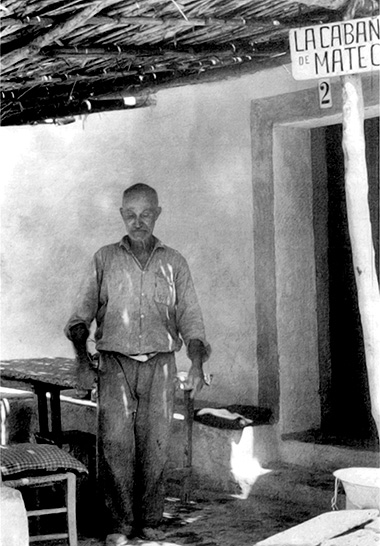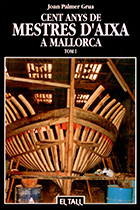Pedra de s'Ase. Mateíto's hiding place
The Serra de Tramuntana is much more than just a succession of landscapes, a charming collection of postcards, or an idyllic catalogue of mountains and valleys. It is also a birthplace. In time, some of those who were born there become figures that are intrinsically linked with a certain location.
This is the case of Mateu Mir Albertí, who was better known by the name Mateíto. He is intrinsically associated with the Banyalbufar hamlet of Pedra de s'Ase. Let us take things step by step though.
Pedra de s'Ase is a small group of houses in the municipality of Banyalbufar, just below Sa Torreta. This is the name given by the people of Banyalbufar to the 16th century watchtower described in tourist guides and on postcards as Torre de ses Ànimes, although historically its name is Torre des Verger. The small hamlet comprises a few second homes, occupied in summer, and the remains of what were originally fishermen's houses. There is also a boat ramp that doubles as a place to sunbathe for bathers. Pedra de s'Ase is a lovely spot.

Mateu Mir built about fifteen lutes, intended for fishermen from Banyalbufar, Esporles and Estellencs
Having presented the place, it just remains for us to introduce the person: Mateu Mir Albertí, known by the nickname Mateíto and born in Banyalbufar in 1891. The oldest townsfolk still remember him and the youngest have heard anecdotes and stories about a figure that, over the course of time, has become a legend.
Mateu Mir emigrated to Cuba when he was under twenty, where he did different jobs, including fishing for sponges. He went from being a fisherman to owning a 13-metre boat that he himself had built. He used the boat to carry sponges, as well as coal, animals and any other cargo that he was asked to transport.
In the 1920s, Cuba was politically unstable and Mateíto settled in Tampa in the USA. It is at this point in the story that legend and reality get jumbled up. One point that is definitely true is that the Prohibition Act benefited rum smuggling from Cuba to the USA more than ever before. Mateíto took an active role in these smuggling activities and one of his clients was no more no less than the famous gangster Al Capone. Some say that relations between Al Capone and Mateu Mir were so close that he came to be one of his right-hand men, while others say that he was only his chauffeur. Others, however, say that Mateu Mir and the most famous gangster in history had a strictly commercial relationship.
Whatever the case, Mateíto went back to Cuba. In the early 1930s, Mateu Mir collaborated actively with General Mario Menocal, who was politically opposed to President Gerardo Machado. Mateu Mir smuggled weapons and men for General Menocal, until he was betrayed and captured when landing cargo. He spent two years in the Isla de Pinos prison, regaining his freedom thanks to Fulgencio Batista, who appointed Carlos Mendieta to the presidency following a coup d'état. Mateu Mir Albertí was named honorary president of Cuba for five years in acknowledgement of his support for the cause and, above all, for not having betrayed anyone during his time in jail. Thus Mateu left politics and devoted himself to other work, including working as a customs inspector, which is not a bad job for an ex-smuggler.
In the mid 1940s, a new change in the political régime forced him to flee Cuba and Mateu Mir Albertí returned to Mallorca, engaging in new adventures on the way when he escaped, hidden in an oil drum, on a merchant vessel.
Back in Banyalbufar, where he arrived with more or less the same fortune as that he had left with, since he had been forced to leave all his belongings on the Caribbean island, Mateíto settled in a little hut in Pedra de s'Ase, which he named Mateo's cabin. He went on to gain a reputation as a great character, thanks to all the anecdotes that he told of his adventures in America and ones for which he was responsible in Mallorca.
In Banyalbufar, he became a mestre d'aixa or builder of wooden boats. He made some fifteen Mallorcan boats known as llaüts, used by fishermen from Banyalbufar, Esporles and Estellencs. His boats were handcrafted and he built them all by himself. Only occasionally did he send wood to the sawmill in Esporles for planks to be made for the outer shell of the boats.
He died in 1975 at the age of 84, leaving behind a life of legendary fame that he himself had fostered and enhanced. Time has also served to forge that legend.
Did you know that...
Mateu Mir Albertí also smuggled goods in Banyalbufar. He had the coastline and the Civil Guard under control, thanks to a system of signals operated with a friend in the village, using flags and bits of material. He was closely familiar with his local surroundings and was enviably agile and fit. He is said to have once arranged to meet some people from Palma to go fishing in Pedra de s'Ase. They met at Banyalbufar and Mateíto told them to drive to Pedra de s'Ase. On arrival, they were amazed to see Mateíto waiting for them. He had set off along tiny paths and jumped from rock to rock along the shore. Mateu Mir was given the nickname Mateíto when he returned from Cuba, because he never lost the accent he had picked up on the Caribbean island. His Mallorcan was spiced with Cuban expressions like caray, concho or auto.
Bibliography

Cent anys de mestres d'aixa a Mallorca
A publication, divided into two volumes, about the work of mestres d'aixa or wooden boat builders. A fascinating compilation of all the master wooden boat builders in Mallorca during the 20th century, it contains information about boat-building techniques and the lives of these craftsmen, who carefully treasured their know-how and skills. One of the chapters of the first volume is devoted to Mateu Mir Albertí, and it contains a list of the boats that he built.
Author: Joan Palmer Grua
Published by: El Tall
Published in: 1994




